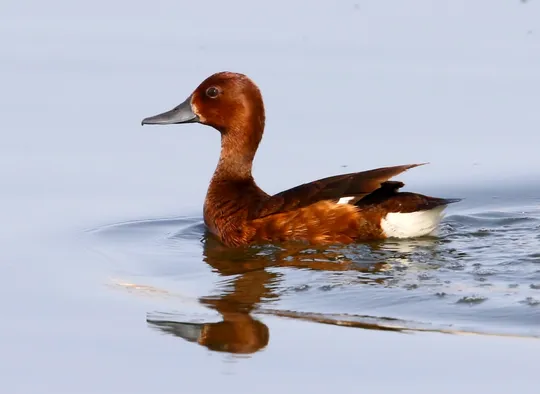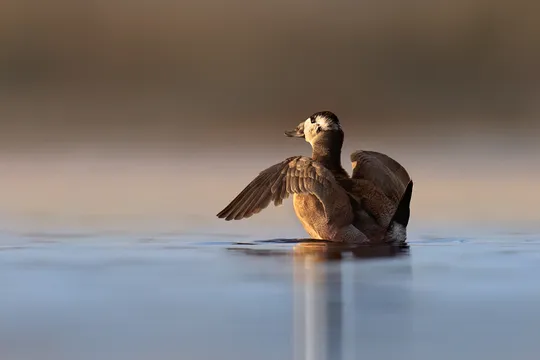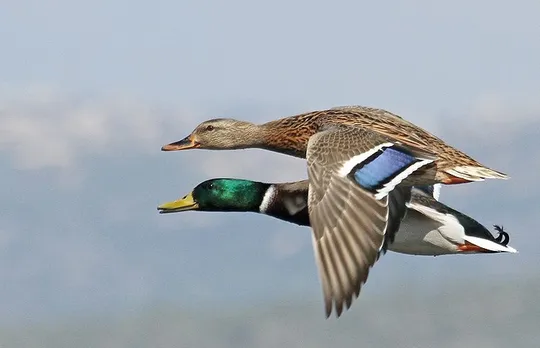Marmaronetta angustirostris
 Endangered
Endangered
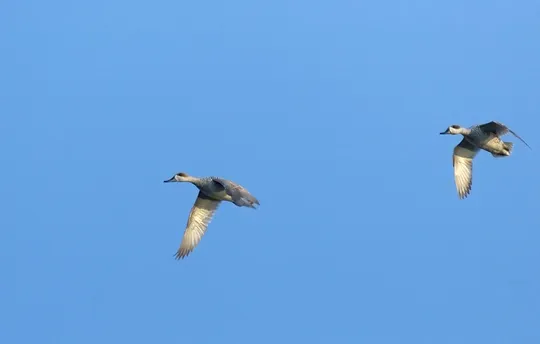
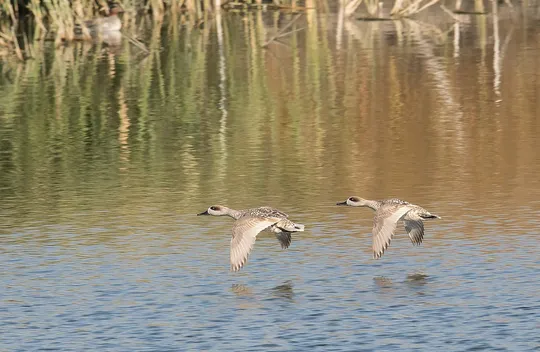
| Habitats | Wetland Thickets |
|---|---|
| Presence In Israel | Resident, Winter Visitor |
| Breeding In Israel | Breeder |
| Migration Types | Resident, Nomad |
| Zoographical Zones | Mediterranean |
| Landscape Types | Wetlands, Fresh Water, Marsh |
| Vegetation Densities | Medium |
| Nest Locations | Ground, Wetland Thickets |
| Diet Types | Invertebrate, Herbivore |
| Foraging Grounds | Water |
| Body Sizes | Small (up to 500g) |
| Threat Factors | Wetland Drainage & Pollution |
The Marbled Teal is a small, delicate duck, with a brown-grey plumage and whitish spots. It has a black eye mask and narrow black bill. In flight, it appears relatively uniform with a prominent eyespot and contrasting dark coverts and white primaries. It favors water reservoirs and marshes with developed bank vegetation that penetrates into the water.
A rare resident species in the Hula and Jezreel valleys and a rare winter visitor in northern Israel and the Judean Lowlands. In surveys conducted in the Northern Valleys in 2013-2014, 30 families were observed each year, distributed almost equally between the Hula and Jezreel valleys (Perlman & Haviv 2013, 2014).
In the late 19th century and in the first half of the 20th century the Marbled Teal was a relatively common breeder in the Hula Valley (the number of pairs was estimated at between 100 and 200). Apparently, it also nested in the Jordan and Bet She’an valleys (Paz 1986, Shirihai 1996). The population decreased drastically during the 1950s, following the drainage of the Hula Lake, and only a few pairs remained nesting in the Hula and a few pairs in the southern Golan Heights. In 1992, the breeding population in the Hula Valley was estimated at about 45 pairs, of which 25 were in the Hula Reserve and the remainder in the fishponds (Eyal Shy, Talia Oron). Surveys by the Israel Ornithological Center found 31 nesting pairs in 2013 (Perlman 2013) and 16 pairs in 2014 (Haviv 2014).
The Marbled Teal nests in marshy landscapes and in shallow water pools with dense bank vegetation. In winter it is seen in open water landscapes, fishponds and reservoirs in the Mediterranean region.
Habitat modification: Loss of freshwater habitats including fish ponds that have either been abandoned or cleared of all vegetation. Reservoirs being covered by polyethylene sheeting and solar panels.
Pollution of water bodies, both by agricultural waste and by pesticides, in particular those used for mosquito control.
Hunting – in winter, Marbled Teals inhabit reservoirs (some in areas open for hunting) along with other duck species and therefore it is exposed to the risk of hunting.
No specific conservation measures have been taken for this species to date. Although the Hula Nature Reserve tries to manage a portion of its marshes specifically for Marbled Teal.
The Marbled Teal is endangered in Israel and globally mainly because of wetland modification and destruction. Its population in Israel is very small, although in recent decades it has remained stable. The future of the species in Israel is dependent on the existence of reservoirs surrounded by bank thickets.
The main factor threatening the future of the Marbled Teal in Israel is the management methods of reservoirs, particularly the cutting of bank vegetation and plans for sealing the reservoirs with polyethylene and solar panels. The thickets surrounding the reservoirs in Marbled Teal breeding grounds should be preserved, as they are necessary for nesting. When work to renew and seal the reservoir is conducted, an alternative habitat that includes thickets in at least part of the reservoir embankment or near it should be created.
- אורון, ט. וגיסיס, ג. 2005. סיכום סקר קינון ברווזים משויישים בעמק החולה (2003-2004). העזניה 33, הוצאת טבע הדברים והחברה להגנת הטבע.
- ארצי, י., אורון, ט. וגיסיס, ג. 2015. קינון ברווז משוייש בעמק החולה: סיכום עונת קינון 2015. דו"ח רשות הטבע והגנים.
- פז, ע. 1986. עופות. מתוך אלון, ע. (עורך), החי והצומח של ארץ ישראל. כרך 6. הוצאת משרד הביטחון, ישראל.
- פרלמן, י. 2013. ברווזים נדירים דוגרים בישראל סיכום ניטור קיץ 2013. דו"ח רשות הטבע והגנים והחברה להגנת הטבע.
- פרלמן, י. וחביב, א. 2014. ברווזים נדירים דוגרים בישראל סיכום ניטור קיץ 2014. דו"ח רשות הטבע והגנים והחברה להגנת הטבע.
- Shirihai, H., 1996. The Birds of Israel. Academic Press, London.
- Symes, A. 2013. Species generation lengths. Unpublished, BirdLife International.
- Species page at Birdlife International
Current Occupancy Map
| Data Missing | Sporadic | Limited Sites | Low Density | High Density |
|---|---|---|---|---|
| 0 | 0 | 0 | 0 | 0 |
Distribution maps
The maps presented here provide visual information on the distribution of species in Israel from the past and present, and the changes in occupancy and breeding density during the comparison period. For further reading
Relative Abundance 2010-2020
Breeding density values in the current decade as determined from experts' opinion and observations from databases.
| Data Missing | Sporadic | Limited Sites | Low Density | High Density |
|---|---|---|---|---|
| 8 | 12 | 12 | 21 | 19 |
Relative Abundance 1980-1990
Density values based primarily on the book The Birds of Israel (Shirihai 1996).
| Data Missing | Sporadic | Limited Sites | Low Density | High Density |
|---|---|---|---|---|
| 5 | 14 | 14 | 17 | 22 |
Occupancy 1990-2020
The map shows differences in the species breeding distribution between the 1980's breeding map and the current weighted breeding evaluation. Negative value - species previously bred in the grid and is not presently breeding; positive value - species has not previously bred in the grid and is currently breeding.
| Data Missing | No Change | Occupancy Increase | Occupancy Decrease |
|---|---|---|---|
| 6 | 35 | 1 | 9 |
Change in Relative Abundance 1990-2020
The map shows the changes in the relative abundance of a species in each of the distribution grids between the breeding map of the 1980s and the weighted current breeding evaluation. Negative values - decline in abundance; positive values - increase in abundance; zero - no change in abundance.
| 80 to 100 | 50 | 20 to 30 | No Change | 30- to 20- | 50- | 100- to 80- | Data Missing |
|---|---|---|---|---|---|---|---|
| 0 | 4 | 2 | 22 | 12 | 14 | 11 | 16 |
| Rarity | |
|---|---|
| Vulnerability | |
| Attractiveness | |
| Endemism | |
| Red number | |
| Peripherality | |
| IUCN category | |
| Threat Definition according to the red book |
 Contributed:
Contributed: 